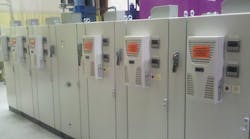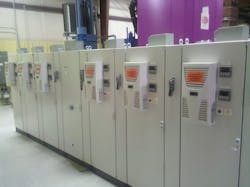With the proliferation of business-critical control equipment on the plant and factory floor, many supervisors need scalable, configurable housing for their sensitive electronics. To provide more versatility and a smaller footprint for users, modular-design enclosures consist of a basic structure formed by an internal metal frame supporting an external “skin” that can be composed of various materials (Fig. 1).
With some initial consideration of the enclosure’s environment and the electronics to be housed within, modular enclosures offer users many popular material and design features:
1. Environmental Protection
Just like traditional unibody designs, modular enclosures can be certified to rugged industry standards (NEMA 250, UL 50/50E), giving them the same environmental-protective ratings (3R, 12, 4, 4X, etc.).
Though many possible types of physical stressors exist in a plant or factory environment, modular enclosure designs can account for each one with a variety of construction materials. Before deciding on a choice of materials, first consider whether the enclosure’s environment is likely to include such stressors as tampering, impact, water leaks, mold, corrosion, or any other potential source of damage. It’s also wise to design for flexibility with future modifications in mind.
Metallic or non-?
Naturally, an enclosure’s specifications (durability, life expectancy, etc.) depend heavily on the choice of its construction material. When planning for an installation, consider how much material strength and impact resistance is needed to give the necessary environmental protection for the electronics inside:
- Metallic enclosures have the density, strength, and weight to carry a greater load and typically are the stronger choice. Painted carbon steel, and stainless steel in Type 304 or 316, offer excellent protection against undesired access and environmental corrosion. Unlike non-metallic enclosures, they’re more tamper-proof and if damaged, any panel can easily be replaced due to the modular design concept.
- Non-metallic enclosures are the lighter but overall less robust choice, making them ideal for wall-or pole-mounted installations. Fiberglass-reinforced polyester enclosures are lightweight and resist corrosion and impact, while polycarbonate enclosures are also impact- and corrosion-resistant and tend to be more UV-resistant than fiberglass versions for an overall longer product life.
Construction material review
Carbon steel: Painted carbon steel is a mainstay of indoor enclosure design, owing to its good strength and value for cost. The paint adds a semi-durable coating, but overall stainless is the better choice for corrosive applications.
Stainless steel: Two common types often incorporated into enclosures include:
- Type 304: Chromium content in steel improves enclosure lifetime by resisting oxidation and corrosive materials such as acids. Since water is a mild corrosive, Type 304 is also used for enclosures that will be exposed to washdown procedures.
- Type 316: Molybdenum content in steel adds extra protection against corrosion in general, whether from outdoor elements such as humidity or indoor sources such as hazardous materials.
Polycarbonate: Lightweight and strong, polycarbonate (thermoplastic polymer) enclosures offer good durability and UV resistance, making them an excellent choice for outdoor installations. Many users prefer them for their portability and resize them to store compact electronic devices.
Fiberglass-reinforced polyester: These enclosures give strong protection to the contents within while also holding up well against corrosion, although lengthy UV exposure will alter its finish (but not its integrity).
Be sure to properly assess all environmental parameters including:
- Local weather conditions (Temperature/RH/Solar)
- Corrosive substances, including particles, gas, and vapor
- Every enclosure assembly has components with its own specific resistance levels (i.e., windows, gaskets). Identify this to avoid weak spots where corrosion could enter.
2. Climate Control
Among the advantages offered by modular designs, one of the key benefits is the ability to be compartmentalized.
One of the main advantages of modular designs is their ability to be compartmentalized, for example to house separate pieces of IT equipment such as servers and smart devices. If you require interior climate control for your electronics, many modular enclosures feature thermal isolation accessories.
A function of compartmentalization, thermal isolation allows users to store different types of electronic equipment, each with its own cooling requirements, all in the same enclosure. This removes the need to source several cabinets and climate-control systems. For example, users could install a compact cooling system to thermally isolate the interior or even maintain it below ambient temperature, instead of a larger system, reducing power consumption.
- Metallic enclosures: In a metallic enclosure, heat is dissipated or absorbed, owing to thermal Carbon or stainless steel is particularly suitable for applications where you need to keep the interior cool.
- Fiberglass and polycarbonate enclosures by contrast offer much slower rates of thermal transfer, locking in heat like insulation. This may make them better suited for keeping electronics above their minimum operating temperature in cold areas.
3. EMI/RF Shielding
Radio frequency interference (RFI)—always prevalent when working with certain electronics and communication equipment—is only expected to increase thanks to the sheer number of wireless devices used in industry. Left unaddressed, these electrical signals can impact your electronic equipment’s operation and performance. Likewise, electromagnetic interference is caused by welding equipment and most electronics with switching contacts that cause small arcs or sparks releasing electromagnetic energies.
In some enclosure applications, users need to prevent outside electromagnetic interference and/or to prevent the devices inside from likewise interfering with other nearby devices. Differently constructed enclosures offer varying levels of protection against external EMI and RF interference:
- All-metal enclosures offer some level of protection against radio and EMI signals. They can also “quarantine” electronics within so that no exterior signals reach them and vice versa.
- Non-metallic enclosures (of the types listed above) can’t protect against EMI in and of themselves. However, a metal coating can be added to the inside or outside of polycarbonate or fiberglass enclosures to provide effective RF and EMI isolation, depending on whether you are trying to isolate the “noise” or keep it from entering the enclosure.
4. Visual Transparency
A viewing window can save users considerable time otherwise spent opening the enclosure to check on the electronics inside. Windows can also give a view to display indicators or to dashboards showing process-critical values.
Many window materials are available for different applications. Glass isn’t recommended for modern enclosure windows due to its greater expense, weight, and comparative lack of insulation. Newer and more durable options include:
- Acrylic (or Plexiglas), which is a lower-cost material with a soft surface resisting impacts and scratches. As a flexible material, acrylic cracks without shattering, while giving good clarity and filtering UV light. Acrylic also offers strong weather resistance.
- Polycarbonate (or Lexan), which is a costlier material choice but is more tamper- and chip-resistant than acrylic. Polycarbonate windows offer better heat stability and can be fitted with watertight seals. Aesthetically, though, it’s more prone to scratching and aging to a yellow color. However, coatings are available to boost its scratch resistance, weathering, and light transmission.
5. Ease of Modification
Modular designs make it easy for users to swap parts out for new ones and modify panels with safe, ergonomic methods, thus increasing worker safety and saving time and labor cost.
When selecting an enclosure, make sure to account for possible future modifications. While thick-gauge steel gives great protection, its hardness also makes it difficult and time-consuming to cut and modify. Unibody enclosures are thicker and far more taxing to modify than modular enclosures, which are lighter and offer more choices for door and panel positions.
With a modular enclosure, you may not have to weld or cut material in the first place. Designed to be customized as needed, they feature turnkey solutions that are interchangeable with the standard panels, reducing the need to have metal-cutting tools on hand in order to do modifications.
By their very nature, a main benefit of modular enclosures is their ease of configuration. Although modular enclosures are available in standard sizes, users can add various entry and access points at the front, rear, or side to suit their application. Extra mounting panels and different door sizes are other possibilities. Modular enclosures also offer scalability in the same footprint. Especially useful for plant floors where space is limited, modular designs enable users to store all compact equipment in the same cabinet, saving space and simplifying maintenance.
Reconfiguration, if necessary, is much easier to perform in the field with a modular equipment enclosure than when using a unibody design. Consisting of parts designed to be easily reconfigured, modular designs make it easy for users to swap parts out for new ones without needing to weld or cut metal, saving time and labor cost. This versatility is equally useful if the enclosure is meant to be part of an existing machine. Users can also join multiple frames together to create flexible configurations such as top-to-bottom, side-to-side, back-to-back, and side-to-back.
Summary
No matter the environment or application, modular enclosures offer solid protection for industrial electronics. Physical and electrical threats alike can be easily mitigated by the correct choice of construction materials and design. Meanwhile their compact footprint and ease of configuration recommend them as scalable, future-proof solutions.
Steve Sullivan is Training & Development Supervisor at Rittal North America LLC.



